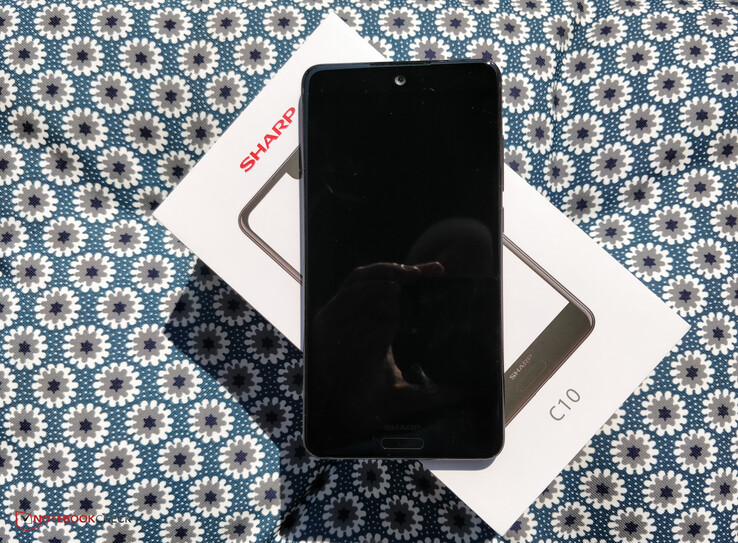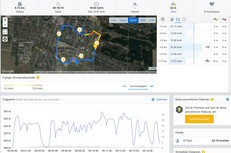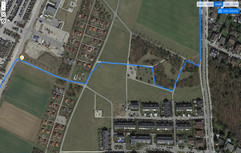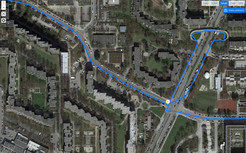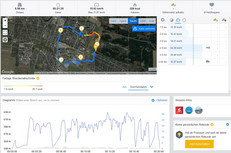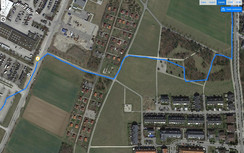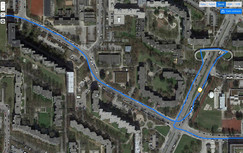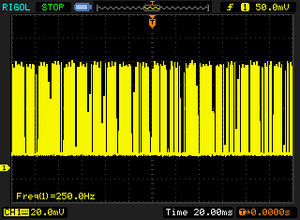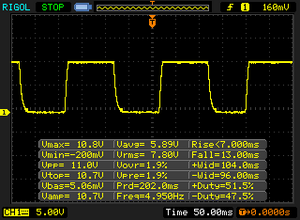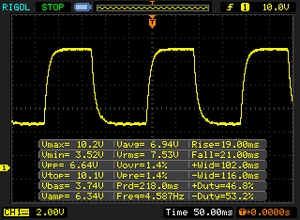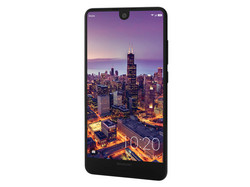Breve Análise do Smartphone Sharp Aquos C10
Os Top 10
» Os Top 10 Portáteis Multimídia
» Os Top 10 Portáteis de Jogos
» Os Top 10 Portáteis Leves para Jogos
» Os Top 10 Portáteis Acessíveis de Escritório/Empresariais
» Os Top 10 Portáteis Premium de Escritório/Empresariais
» Os Top 10 dos Portáteis Workstation
» Os Top 10 Subportáteis
» Os Top 10 Ultrabooks
» Os Top 10 Conversíveis
» Os Top 10 Tablets
» Os Top 10 Smartphones
» A melhores Telas de Portáteis Analisadas Pela Notebookcheck
» Top 10 dos portáteis abaixo dos 500 Euros da Notebookcheck
» Top 10 dos Portáteis abaixo dos 300 Euros
Size Comparison
| Networking | |
| iperf3 transmit AX12 | |
| BQ Aquaris X2 Pro | |
| Sharp Aquos C10 | |
| JVC J20 | |
| Honor View 10 | |
| LG Q7 Plus | |
| iperf3 receive AX12 | |
| Sharp Aquos C10 | |
| BQ Aquaris X2 Pro | |
| JVC J20 | |
| Honor View 10 | |
| LG Q7 Plus | |
| |||||||||||||||||||||||||
iluminação: 92 %
iluminação com acumulador: 548 cd/m²
Contraste: 1118:1 (Preto: 0.49 cd/m²)
ΔE ColorChecker Calman: 5.21 | ∀{0.5-29.43 Ø4.78}
ΔE Greyscale Calman: 6.1 | ∀{0.09-98 Ø5}
95.8% sRGB (Calman 2D)
Gamma: 2.228
CCT: 7538 K
| Sharp Aquos C10 IPS, 2040x1080, 5.5" | BQ Aquaris X2 Pro LTPS, 2160x1080, 5.7" | JVC J20 IPS, 2160x1080, 5.7" | LG Q7 Plus IPS, 2160x1080, 5.5" | Honor View 10 IPS, 2160x1080, 6" | |
|---|---|---|---|---|---|
| Screen | 11% | -32% | -12% | 29% | |
| Brightness middle (cd/m²) | 548 | 675 23% | 411 -25% | 431 -21% | 530 -3% |
| Brightness (cd/m²) | 535 | 650 21% | 426 -20% | 419 -22% | 523 -2% |
| Brightness Distribution (%) | 92 | 92 0% | 82 -11% | 89 -3% | 88 -4% |
| Black Level * (cd/m²) | 0.49 | 0.46 6% | 0.53 -8% | 0.58 -18% | 0.35 29% |
| Contrast (:1) | 1118 | 1467 31% | 775 -31% | 743 -34% | 1514 35% |
| Colorchecker dE 2000 * | 5.21 | 5.9 -13% | 8.84 -70% | 6.2 -19% | 2.4 54% |
| Colorchecker dE 2000 max. * | 13.47 | 9.5 29% | 15.08 -12% | 10.1 25% | 5.5 59% |
| Greyscale dE 2000 * | 6.1 | 6.6 -8% | 10.7 -75% | 6.2 -2% | 2.2 64% |
| Gamma | 2.228 99% | 2.36 93% | 2.433 90% | 2.26 97% | 2.25 98% |
| CCT | 7538 86% | 7846 83% | 10717 61% | 8064 81% | 6598 99% |
* ... menor é melhor
Cintilação da tela / PWM (modulação por largura de pulso)
| Tela tremeluzindo/PWM detectado | 250 Hz | ≤ 10 % configuração de brilho | |
A luz de fundo da tela pisca em 250 Hz (pior caso, por exemplo, utilizando PWM) Cintilação detectada em uma configuração de brilho de 10 % e abaixo. Não deve haver cintilação ou PWM acima desta configuração de brilho. A frequência de 250 Hz é relativamente baixa, portanto, usuários sensíveis provavelmente notarão cintilação e sentirão fadiga ocular na configuração de brilho indicada e abaixo. [pwm_comparison] Em comparação: 53 % de todos os dispositivos testados não usam PWM para escurecer a tela. Se PWM foi detectado, uma média de 8111 (mínimo: 5 - máximo: 343500) Hz foi medida. | |||
Exibir tempos de resposta
| ↔ Tempo de resposta preto para branco | ||
|---|---|---|
| 20 ms ... ascensão ↗ e queda ↘ combinadas | ↗ 7 ms ascensão | |
| ↘ 13 ms queda | ||
| A tela mostra boas taxas de resposta em nossos testes, mas pode ser muito lenta para jogadores competitivos. Em comparação, todos os dispositivos testados variam de 0.1 (mínimo) a 240 (máximo) ms. » 42 % de todos os dispositivos são melhores. Isso significa que o tempo de resposta medido é semelhante à média de todos os dispositivos testados (20.2 ms). | ||
| ↔ Tempo de resposta 50% cinza a 80% cinza | ||
| 40 ms ... ascensão ↗ e queda ↘ combinadas | ↗ 19 ms ascensão | |
| ↘ 21 ms queda | ||
| A tela mostra taxas de resposta lentas em nossos testes e será insatisfatória para os jogadores. Em comparação, todos os dispositivos testados variam de 0.165 (mínimo) a 636 (máximo) ms. » 60 % de todos os dispositivos são melhores. Isso significa que o tempo de resposta medido é pior que a média de todos os dispositivos testados (31.6 ms). | ||
| AnTuTu v6 - Total Score (classificar por valor) | |
| Sharp Aquos C10 | |
| BQ Aquaris X2 Pro | |
| JVC J20 | |
| LG Q7 Plus | |
| Honor View 10 | |
| Média Qualcomm Snapdragon 630 (44128 - 73617, n=12) | |
| AnTuTu v7 - Total Score (classificar por valor) | |
| Sharp Aquos C10 | |
| BQ Aquaris X2 Pro | |
| JVC J20 | |
| LG Q7 Plus | |
| Média Qualcomm Snapdragon 630 (87300 - 90674, n=11) | |
| PCMark for Android | |
| Work performance score (classificar por valor) | |
| Sharp Aquos C10 | |
| BQ Aquaris X2 Pro | |
| JVC J20 | |
| LG Q7 Plus | |
| Honor View 10 | |
| Média Qualcomm Snapdragon 630 (4948 - 6264, n=13) | |
| Work 2.0 performance score (classificar por valor) | |
| Sharp Aquos C10 | |
| BQ Aquaris X2 Pro | |
| JVC J20 | |
| LG Q7 Plus | |
| Honor View 10 | |
| Média Qualcomm Snapdragon 630 (4636 - 5987, n=12) | |
| GFXBench (DX / GLBenchmark) 2.7 | |
| T-Rex Onscreen (classificar por valor) | |
| Sharp Aquos C10 | |
| BQ Aquaris X2 Pro | |
| JVC J20 | |
| LG Q7 Plus | |
| Honor View 10 | |
| Média Qualcomm Snapdragon 630 (25 - 31, n=13) | |
| Média da turma Smartphone (12 - 166, n=157, últimos 2 anos) | |
| 1920x1080 T-Rex Offscreen (classificar por valor) | |
| Sharp Aquos C10 | |
| BQ Aquaris X2 Pro | |
| JVC J20 | |
| LG Q7 Plus | |
| Honor View 10 | |
| Média Qualcomm Snapdragon 630 (29 - 30, n=13) | |
| Média da turma Smartphone (22 - 954, n=157, últimos 2 anos) | |
| GFXBench 3.0 | |
| on screen Manhattan Onscreen OGL (classificar por valor) | |
| Sharp Aquos C10 | |
| BQ Aquaris X2 Pro | |
| JVC J20 | |
| LG Q7 Plus | |
| Honor View 10 | |
| Média Qualcomm Snapdragon 630 (11 - 15, n=13) | |
| Média da turma Smartphone (18 - 166, n=159, últimos 2 anos) | |
| 1920x1080 1080p Manhattan Offscreen (classificar por valor) | |
| Sharp Aquos C10 | |
| BQ Aquaris X2 Pro | |
| JVC J20 | |
| LG Q7 Plus | |
| Honor View 10 | |
| Média Qualcomm Snapdragon 630 (13 - 14, n=13) | |
| Média da turma Smartphone (12 - 606, n=157, últimos 2 anos) | |
| GFXBench 3.1 | |
| on screen Manhattan ES 3.1 Onscreen (classificar por valor) | |
| Sharp Aquos C10 | |
| BQ Aquaris X2 Pro | |
| JVC J20 | |
| LG Q7 Plus | |
| Honor View 10 | |
| Média Qualcomm Snapdragon 630 (5.3 - 11, n=13) | |
| Média da turma Smartphone (11 - 166, n=158, últimos 2 anos) | |
| 1920x1080 Manhattan ES 3.1 Offscreen (classificar por valor) | |
| Sharp Aquos C10 | |
| BQ Aquaris X2 Pro | |
| JVC J20 | |
| LG Q7 Plus | |
| Honor View 10 | |
| Média Qualcomm Snapdragon 630 (5.2 - 10, n=13) | |
| Média da turma Smartphone (8.4 - 413, n=158, últimos 2 anos) | |
| GFXBench | |
| on screen Car Chase Onscreen (classificar por valor) | |
| Sharp Aquos C10 | |
| BQ Aquaris X2 Pro | |
| JVC J20 | |
| LG Q7 Plus | |
| Honor View 10 | |
| Média Qualcomm Snapdragon 630 (4.3 - 6, n=13) | |
| Média da turma Smartphone (5.5 - 154, n=161, últimos 2 anos) | |
| 1920x1080 Car Chase Offscreen (classificar por valor) | |
| Sharp Aquos C10 | |
| BQ Aquaris X2 Pro | |
| JVC J20 | |
| LG Q7 Plus | |
| Honor View 10 | |
| Média Qualcomm Snapdragon 630 (5.3 - 5.6, n=13) | |
| Média da turma Smartphone (3.5 - 216, n=160, últimos 2 anos) | |
| JetStream 1.1 - Total Score | |
| BQ Aquaris X2 Pro (Chrome 67) | |
| Honor View 10 (Chrome 63) | |
| Média Qualcomm Snapdragon 630 (27.4 - 30.8, n=12) | |
| Sharp Aquos C10 (Chrome 68) | |
| JVC J20 (Chrome 68) | |
| LG Q7 Plus (Chrome 67) | |
| Octane V2 - Total Score | |
| Média da turma Smartphone (2228 - 121337, n=201, últimos 2 anos) | |
| BQ Aquaris X2 Pro (Chrome 67) | |
| Honor View 10 (Chrome 63) | |
| Sharp Aquos C10 (Chrome 68) | |
| JVC J20 (Chrome 68) | |
| Média Qualcomm Snapdragon 630 (4398 - 5202, n=13) | |
| LG Q7 Plus (Chrome 67) | |
| Mozilla Kraken 1.1 - Total | |
| LG Q7 Plus (Chrome 67) | |
| Média Qualcomm Snapdragon 630 (8396 - 10257, n=13) | |
| JVC J20 (Chrome 68) | |
| Sharp Aquos C10 (Chrome 68) | |
| Honor View 10 (Chrome 63) | |
| BQ Aquaris X2 Pro (Chrome 67) | |
| Média da turma Smartphone (257 - 28190, n=156, últimos 2 anos) | |
| WebXPRT 2015 - Overall | |
| BQ Aquaris X2 Pro (Chrome 67) | |
| Honor View 10 (Chrome 63) | |
| Sharp Aquos C10 (Chrome 68) | |
| Média Qualcomm Snapdragon 630 (86 - 117, n=10) | |
| LG Q7 Plus (Chrome 67) | |
* ... menor é melhor
| Sharp Aquos C10 | BQ Aquaris X2 Pro | JVC J20 | LG Q7 Plus | Honor View 10 | Média 64 GB eMMC Flash | Média da turma Smartphone | |
|---|---|---|---|---|---|---|---|
| AndroBench 3-5 | -1% | -8% | -14% | 205% | 16% | 960% | |
| Sequential Read 256KB (MB/s) | 283.8 | 280.8 -1% | 270.6 -5% | 235.9 -17% | 810 185% | 277 ? -2% | 2223 ? 683% |
| Sequential Write 256KB (MB/s) | 213.4 | 204.8 -4% | 199.7 -6% | 186.6 -13% | 194.3 -9% | 178.4 ? -16% | 1838 ? 761% |
| Random Read 4KB (MB/s) | 48.2 | 51.3 6% | 58.3 21% | 35.8 -26% | 144.3 199% | 60.7 ? 26% | 295 ? 512% |
| Random Write 4KB (MB/s) | 16.9 | 15.43 -9% | 6.3 -63% | 11.91 -30% | 160 847% | 33.8 ? 100% | 335 ? 1882% |
| Sequential Read 256KB SDCard (MB/s) | 83 ? | 83.3 ? 0% | 82.8 ? 0% | 81.4 ? -2% | 81 ? -2% | 77.4 ? -7% | |
| Sequential Write 256KB SDCard (MB/s) | 60.7 ? | 61.1 ? 1% | 63 ? 4% | 62.2 ? 2% | 65.1 ? 7% | 58.3 ? -4% |
| Arena of Valor | |||
| Configurações | Valor | ||
| min | 31 fps | ||
| high HD | 30 fps | ||
| Shadow Fight 3 | |||
| Configurações | Valor | ||
| high | 56 fps | ||
| minimal | 55 fps | ||
(±) A temperatura máxima no lado superior é 40.4 °C / 105 F, em comparação com a média de 35.2 °C / 95 F , variando de 21.9 a 247 °C para a classe Smartphone.
(±) A parte inferior aquece até um máximo de 42.8 °C / 109 F, em comparação com a média de 34 °C / 93 F
(+) Em uso inativo, a temperatura média para o lado superior é 31.4 °C / 89 F, em comparação com a média do dispositivo de 32.9 °C / ### class_avg_f### F.
Sharp Aquos C10 análise de áudio
(±) | o volume do alto-falante é médio, mas bom (###valor### dB)
Graves 100 - 315Hz
(-) | quase nenhum baixo - em média 60.1% menor que a mediana
(+) | o baixo é linear (0% delta para a frequência anterior)
Médios 400 - 2.000 Hz
(-) | quase nenhum médio - em média 60.1% menor que a mediana
(+) | médios são lineares (0% delta para frequência anterior)
Altos 2 - 16 kHz
(-) | quase nenhum máximo - em média 60.1% menor que a mediana
(+) | os máximos são lineares (0% delta da frequência anterior)
Geral 100 - 16.000 Hz
(-) | o som geral não é linear (116.7% diferença em relação à mediana)
Comparado com a mesma classe
» 87% de todos os dispositivos testados nesta classe foram melhores, 6% semelhantes, 7% piores
» O melhor teve um delta de 11%, a média foi 35%, o pior foi 134%
Comparado com todos os dispositivos testados
» 96% de todos os dispositivos testados foram melhores, 2% semelhantes, 2% piores
» O melhor teve um delta de 4%, a média foi 24%, o pior foi 134%
JVC J20 análise de áudio
(±) | o volume do alto-falante é médio, mas bom (###valor### dB)
Graves 100 - 315Hz
(-) | quase nenhum baixo - em média 60.9% menor que a mediana
(+) | o baixo é linear (0% delta para a frequência anterior)
Médios 400 - 2.000 Hz
(-) | quase nenhum médio - em média 60.9% menor que a mediana
(+) | médios são lineares (0% delta para frequência anterior)
Altos 2 - 16 kHz
(-) | quase nenhum máximo - em média 60.9% menor que a mediana
(+) | os máximos são lineares (0% delta da frequência anterior)
Geral 100 - 16.000 Hz
(-) | o som geral não é linear (121.1% diferença em relação à mediana)
Comparado com a mesma classe
» 90% de todos os dispositivos testados nesta classe foram melhores, 8% semelhantes, 2% piores
» O melhor teve um delta de 11%, a média foi 35%, o pior foi 134%
Comparado com todos os dispositivos testados
» 97% de todos os dispositivos testados foram melhores, 2% semelhantes, 1% piores
» O melhor teve um delta de 4%, a média foi 24%, o pior foi 134%
| desligado | |
| Ocioso | |
| Carga |
|
Key:
min: | |
| Sharp Aquos C10 2700 mAh | BQ Aquaris X2 Pro 3100 mAh | JVC J20 3400 mAh | LG Q7 Plus 3000 mAh | Honor View 10 3750 mAh | Média Qualcomm Snapdragon 630 | Média da turma Smartphone | |
|---|---|---|---|---|---|---|---|
| Power Consumption | 21% | 21% | 27% | 4% | 30% | 9% | |
| Idle Minimum * (Watt) | 0.9 | 0.63 30% | 1 -11% | 1 -11% | 1.05 -17% | 0.732 ? 19% | 0.848 ? 6% |
| Idle Average * (Watt) | 2.2 | 2.16 2% | 1.6 27% | 1.57 29% | 2.36 -7% | 1.835 ? 17% | 1.434 ? 35% |
| Idle Maximum * (Watt) | 3.8 | 2.18 43% | 2.8 26% | 1.64 57% | 2.41 37% | 2.16 ? 43% | 1.618 ? 57% |
| Load Average * (Watt) | 6.2 | 4.48 28% | 4 35% | 4.1 34% | 4.93 20% | 3.81 ? 39% | 7.01 ? -13% |
| Load Maximum * (Watt) | 8 | 7.87 2% | 5.9 26% | 6.02 25% | 9.04 -13% | 5.62 ? 30% | 11.3 ? -41% |
* ... menor é melhor
| Sharp Aquos C10 2700 mAh | BQ Aquaris X2 Pro 3100 mAh | JVC J20 3400 mAh | LG Q7 Plus 3000 mAh | Honor View 10 3750 mAh | |
|---|---|---|---|---|---|
| Duração da bateria | -18% | 8% | -24% | 11% | |
| Reader / Idle (h) | 23.8 | 22.9 -4% | 16.3 -32% | 27.9 17% | |
| H.264 (h) | 12.3 | 11 -11% | 7.6 -38% | 13.7 11% | |
| WiFi v1.3 (h) | 11.2 | 10.1 -10% | 12.1 8% | 10.3 -8% | 11.3 1% |
| Load (h) | 4.5 | 2.4 -47% | 3.8 -16% | 5.1 13% |
Pro
Contra
O retorno da Sharp ao mercado ocidental de smartphones é uma tarefa difícil, e, com o Sharp Aquos C10, ela consegue, na primeira tentativa, lançar um sólido dispositivo de gama média no mercado. O smartphone pode convencer com uma tela brilhante, boas câmeras, uma duração de bateria decente e uma WLAN rápida. O desempenho é totalmente suficiente, e o smartphone Sharp parece rápido no geral. No entanto, existem alguns smartphones nessa faixa de preço que trazem significativamente mais potência. Além disso, o Sharp Aquos C10 se afoga visivelmente durante cargas mais longas.
Com o Aquos C10, a Sharp consegue uma boa reentrada no mercado ocidental. Particularmente, as câmeras, a velocidade WLAN e a duração da bateria, são convincentes.
Por outro lado, um comprador em potencial pode ficar incomodado com a falta de uma porta de 3,5 mm, a qualidade de voz medíocre e, é claro, o nível que representa um obstáculo para alguns. Aqueles que podem apreciar o formato incomum do Sharp Aquos C10 e não precisam de tanto poder, terão um bom smartphone que nem todos têm.
Sharp Aquos C10
- 09/27/2019 v7 (old)
Florian Wimmer




